CHAPTER 6
Feet First
FOR MILLIONS OF YEARS, our feet and legs have been our primary means of locomotion and in the forefront of responses to “fight, flight, or freeze” survival strategies. Our limbic brain (also called the mammalian brain) is at the center of our emotional response system. Its major function is to react instantaneously to incoming information from the environment. Emotional reactions, as we know, occur prior to thought. Before we’ve had time to develop any conscious plan, our limbic brain has already made sure that our feet and legs, depending on the situation, are geared to run away, kick out in defense, or freeze in place.
And we’re hardwired for these reactions to threats. Although the hazards are very different in a modern business setting, whenever we are faced with something we perceive to be dangerous or even disagreeable, our feet and legs still respond in the same way: they freeze first, attempt to distance second, and finally, if no other alternative is available, prepare to fight and kick.
Joe Navarro worked for the FBI in behavioral analysis for fifteen years. Now he teaches body language skills to professional poker players. His advice? “I tell people to watch the feet, the hands, and the face—in that order. These are the most honest parts of the body.”
Don’t let the short length of this chapter fool you. It contains some of the most fascinating and useful clues for reading people. You’ll discover how to spot anxiety, anticipation, welcome, exclusion, interest, and the desire to retreat—just by reading the signals sent by someone’s legs and feet.
When people try to control their body language, they focus primarily on facial expressions and hand and arm gestures. Take politicians for example.
The major political parties train their candidates to project a favorable image of themselves and the party. Nonverbal communication plays a very significant role in establishing and maintaining this image. Politicians are coached to smile, make good eye contact, and cultivate a firm, warm handshake. When seated they are urged to adopt a forward-leaning posture that indicates a desire to cooperate with the listener in discussion.
But rarely is any public figure—politician, entertainer, or executive—coached in body language below the waist. And because gestures from the legs and the feet are left unrehearsed, they are also where the truth can most often be found. When it comes to reading nonverbal cues, professionals know that the feet, not the face, offer the most accurate and candid reflection of emotion.
Feet That Can’t Stand to Lie
When lying, most people increase the number of times their feet move. Feet fidget, shuffle, and wind around each other or around the furniture. They stretch and curl to relieve tension. They may even wriggle or kick out in a symbolic attempt to run away.
You may not know it, but instinctively you’ve been reacting to foot gestures all your life. Studies show that observers, regardless of whether they realize they’re “reading feet,” have greater success exposing a person’s falsehoods when they can see the entire body. No wonder so many business professionals are more comfortable interacting with others when a big desk hides their lower body!
TRY THIS The next time you have a meeting with someone you want to evaluate or get to know better, get him out from behind the desk or conference table. Sit where you can view his entire body. Even if you don’t do so consciously, you will pick up nonverbal cues from his feet and leg movements—cues that will add substantially to your overall understanding of the person. |
Happy Feet
Our feet and legs not only react to stressors and threats but respond to positive emotions as well. “Dancing for joy,” “kicking up your heels,” “walking on air,” and “staying on your toes” are some of the phrases used to acknowledge that positive connection.
Someone who plays cards regularly may know when one of his buddies has a good hand because, despite having assumed a noncommittal “poker face,” the friend’s twitching legs or bouncing feet always give him away.
Bouncing, tapping, wiggling feet are what professional poker players refer to as “happy feet.” In poker it’s a high-confidence tell—a signal that the player’s hand is strong and opponents should beware.
There is a similar signal in business negotiations. If you see a lot of high-energy foot jiggling, or if you notice a slight bounce in the shoulders as a result of the movement, you can almost always assume that the party involved is feeling pretty good about his bargaining position.
In the opposite case, with a negotiator who is constantly bouncing her legs and suddenly stops right after she has presented an offer, it’s probably a gesture of heightened anticipation—the equivalent of holding her breath.
Like any other nonverbal signal, bouncy feet need to be compared with a person’s baseline. If someone has naturally jittery legs or feet (his normal reaction to stress), the happy feet signal is harder to detect.
Feet That Want to Be Somewhere Else
Imagine that you are sitting at the kitchen table with a three-year-old boy who would rather be outside playing. There he is, with his feet stretching to reach the floor even before he’s finished eating. His upper body may be dutifully facing the table, but his legs and feet are already twisting and inching toward the door.
Think we give up this behavior as adults? Think again. It’s ingrained. We may be more restrained but only marginally so. Our feet turn away from things we want to avoid, and they point in the direction we’d prefer to be going.
TRY THIS Whenever you are speaking with a co-worker or client who seems to be paying attention, whose upper body is angled toward you but whose legs and feet have turned toward the door—look closer. If he jiggles or taps a foot, especially toward the exit, he may be symbolically running away. |
Foot positions are revealing even if someone’s legs are crossed. If the toe of the leg that is crossed is pointing toward you, the person is most likely with you emotionally. If the toe is pointing away, especially if it’s pointing at the door, she is probably withdrawing.
Feet That Include or Exclude
Here’s a common workplace situation you could find yourself facing: Two of your work colleagues are talking in the hallway. You’d like to join the conversation, but you don’t know if you’ll be seen as a rude interruption or a welcome addition.
You can find out—just by watching their feet.
When you approach the twosome, you will be acknowledged in one of two ways. If the feet of your two colleagues stay in place, and they twist only their upper torsos in your direction, they don’t really want you to join the conversation. But if their feet open to include you, you know that you are truly invited to participate. The feet nearest you will turn slightly in your direction—a position called triangulation.

Feet that exclude
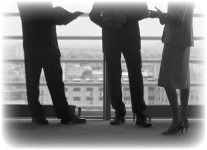
Feet that include
TRY THIS When you see a small group of people talking, look at their feet to see who’s really connecting with whom. If all the feet triangulate or point to the common center of the group, it is an integrated conversation. If not, you’ll be able to tell by the feet positions who is really in and who is being excluded. |
Foot Lock
I was gathering background information for a change-management speech by interviewing various leaders at my client’s company. Knowing that the impending change would have vast implications for her department, I was especially interested to talk with the head of customer service.
When I asked her, “How do you feel about the changes going on here?” the manager replied, “I have no problem. It’s all fine with me.” At which point she crossed her feet tightly at the ankles. “Are you sure?” I asked. She paused for a moment, uncrossed her ankles, and said, “Well, actually, I’m worried sick that we’ll offshore this entire function.”
A foot lock or ankle lock, in which a foot wraps around the opposite leg at the ankle or lower calf, is like having a “closed” sign hanging over the door.
As a therapist, I noticed that individuals who were not revealing information often locked their ankles and, when they finally allowed emotions to flow, they’d unlock their ankles. I’ve seen passengers who are nervous or uncomfortable during airplane takeoffs display the same foot-lock gesture. Human resource professionals notice that most interviewees lock their feet at some point during the interview, indicating that they are holding back an emotion or attitude. And savvy negotiators look for foot locks as a possible sign that someone is holding back a valuable concession.

These feet show who feels included and who feels left out.
Foot locks also occur when people are feeling anxious or threatened. Most people lock their feet at the ankles when they sit in the dental chair. Another foot signal of insecurity or inferiority that you might see around the conference table is toes pointed inward. People may be sitting with the rest of the body open, but their feet are telling the real story.
Open and Closed Leg Positions
In general, open or uncrossed leg positions show an open or dominant attitude, whereas crossed positions are a sign of a closed attitude or uncertainly. People who are relaxed tend to take up more space with their legs. Sitting with legs apart in public is an especially masculine signal indicating a high level of comfort and confidence—although both men and women sit like this when they feel safe or unobserved. At a restaurant, with legs hidden by a tablecloth, both genders prefer this leg position.

Positions of comfort and confidence
Legs Crossed
There are many reasons for people to sit with their legs crossed. Often it is the most comfortable position to assume. Crossing legs at the knee with toes relaxed is the usual option for women. Both genders stretch out their legs and cross them loosely at the ankles, but men do this more often than women. Both poses are silent signals of casualness and ease.
Crossing one leg and resting it on the other thigh (so that the knee opens up) is a very masculine position that takes up a great deal of room and signals that the person is very sure of himself and of his place in the group.
The leg-lock position (a tightly closed leg cross that often accompanies the crossed-arms gesture) is the sitting posture used by many businesspeople who have a competitive nature. It is also a defensive signal used by most people when they are listening to something or someone they disagree with or feel threatened by.
On Bended Knee
“My knees went weak” is more than just an expression. It is a literal truth. In moments of extreme grief or despair, a person’s knees may collapse and fail to hold their legs upright. So, when a police officer on Law and Order has to inform the victim’s wife that her husband has been murdered, the first thing the officer says is “You’d better sit down.” Collapsing knees are the body’s way of saying, “I just can’t stand it anymore.”
Walk This Way
An individual’s stride and pace indicate a variety of meanings, from confidence to depression. When a person is feeling down in the dumps, the head is bowed, the shoulders are stooped, and the person rarely looks up. Instead, the eyes gaze down and the walk is often lethargic. People who are feeling positive and confident usually have an evenly paced gait and look “light on their feet.” Their posture is upright, their heads are straight, and their arms swing at their sides in an easy and relaxed manner.
Former U.S. president Ronald Reagan was called “the great communicator,” and that included his use of body language. One newspaper reporter wrote that Reagan would emerge from behind a closed door in the White House, stride purposefully down a long red-carpeted corridor, then fairly bound onto a platform. His nonverbal message was one of vigor, authority, and ease.
I’ve seen executives walk into a conference room and project that same attitude. Those who do are telling everyone in the room, “I’m in charge here.” And it’s not by anything they say; the message is delivered by their confident walk, physical energy, and relaxed style.
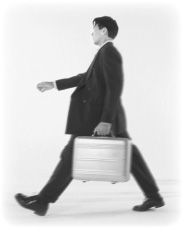
A man “on the go”
People’s training and background also affect how they move. A professional dancer and a military officer carry themselves quite differently—even if both are female. But as unique as someone’s profession and culture may make them, there are still some general signals you can pick up from watching people walk. Fast walkers look competent and busy. Speed and a lengthening stride correlate to a sense of urgency, and a “bounce in the step” signals an upbeat mood. You can even spot gender differences. Men tend to land squarely on their heels and roll toward the balls of their feet, and women catch their weight forward of their heels. Some women actually walk on the balls of their feet.
Standing Positions
There are six main standing positions, and each one tells you something about the attitude of the person assuming that position.
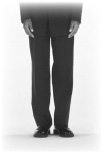
Standing at attention Junior officers addressing senior officers or employees talking to the boss most often assume this respectful, legs-together stance.
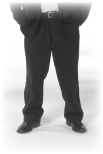
Standing with legs apart Like the seated legs-apart position, standing with legs apart and feet firmly planted on the ground is a predominantly male gesture (the western gunslinger pose) that signals dominance or determination. Putting hands on the hips or folding the arms while in this stance is a masculine gesture of power that also communicates coldness and inapproachability.
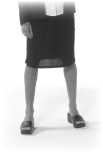
Standing with weight evenly distributed When people are comfortable, they usually balance their weight on both feet. The language that instinctively reflects this posture/attitude connection is “well balanced,” “take a firm stand,” and “knowing where you stand on this.”
Standing with weight constantly shifting When uncomfortable, many people fidget and shift their weight from one foot to the other. They may also rock back and forth as a way to calm themselves during anxious moments.
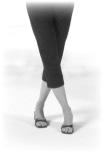
Standing with legs crossed The crossed-legs stance is most often seen coupled with crossed arms. It’s another closed and defensive posture that can also be a sign of low confidence. Many people stand in this position when they are in a group of strangers.
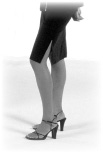
Standing with one foot forward When the body weight is shifted to one hip, it leaves the lead leg and foot free to point in the direction of interest.
TRY THIS At your next business function or social event, watch the different stances that people take. Can you pick out those who are uncomfortable or new to the group by the way they stand? (Most likely they stand with legs crossed or they shift their weight from foot to foot.) When people are in a group, notice where the most feet are pointing. From that observation you can pick out the person who is the most important or interesting in the group—without hearing a word being spoken. |
There’s one more signal, it seems, that our feet send. I didn’t see the need to include it earlier in this chapter, but I’ll do it now—more as a public service and as one more reminder of how much we can learn from paying attention to feet.
It’s most likely due to blood circulation, but it’s apparently a well-known medical principle that warm feet are a sign of life. Not in every case, however, as evidenced by the 1899 death-bed story of John Holmes, the brother of Oliver Wendell Holmes. It seems that John fell into a coma and lay motionless for so long that his caretakers wondered whether he was still alive. One nurse, finding no pulse one day, felt his feet to see if they were warm.
“If they are, that means he’s alive,” she explained to the others in the room. “Nobody ever died with warm feet.” The small group was stunned when the motionless John Holmes, his sense of humor intact till the very end, uttered his last words: “John Rogers did!”
John Rogers, you understand, was the first Protestant martyr in Mary Tudor’s Roman Catholic reign. His feet, of course, were very warm when he died in 1555. He was burned at the stake.

